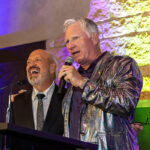3D-Printed Art Comes to Campus
You’ve probably heard about how the rise of 3D printing is revolutionizing the science and technology sector—but did you know it’s transforming the art world, too?
As part of a 3D-printing symposium at UT this week, engineering professor David Bourell asked digital sculptor and Southwestern University art professor Mary Visser to curate an exhibition of 3D-printed art from around the world. Visser chose 37 sculptures, 25 of which were printed on the Forty Acres, to display in the Alumni Center on Tuesday night only. The exhibit was open to the 300-plus engineers attending the conference, and in this case art and science have more in common than you might think. Digital sculpture draws on elements of math, engineering, architecture, and computer programming, and many of the artists have technical backgrounds.
“It’s a field that attracts pioneers and experimenters,” says Visser, who has been digitally designing sculptures since 1985 and started 3D printing them in the late 1990s. “Human beings have been attempting to represent the 3D world since man first started drawing on the walls of caves,” Visser says. “With 3D printing you can scan reality and print all kids of data. Artists are asking questions like, how do you take data that’s not visual and make it visual?”
Below, check out five of the 3D-printed sculptures from the exhibit, which included works from artists ages 18 to 104:
Bathsheba Grossman
Somerville, Mass.
One advantage of digital sculpture is that it allows artists to create forms that wouldn’t be possible to make by hand. “The undercuts in this piece just couldn’t be created in traditional sculpture,” says Visser. Grossman studied math at Yale before becoming an artist.
Between
Dan Collins
Phoenix, AZ
This artist scans individuals to create tiny portraits, accurate down to every last detail—a practice that has already hit the consumer market as a novelty sales item.
Thought Forms
Paul Higham
New York, New York
Higham turns brain waves into sculptures, and this piece depicts someone’s neural activity while reading a poem. This rapidly growing field is known as data sculpture.
Crania-Anatomica-Filigre-Binary
Joshua Harker
Chicago, Ill.
Harker raised more than $77,000 on Kickstarter for this project, making it one of the most popular art projects in the crowdfunding site’s history. “Nesting a sculpture within a sculpture is a popular technique within 3D printing,” Visser says.
Boule-Ondule e-Lumineuse
Alexandre Vitkine
Paris, France
Vitkine, who is still making art at 104 years old, was one of the first digital sculptors. He is the co-founder of Ars Mathematica, an organization that promotes digital sculpture. Vitkine’s sculptures depict light captured with electronic devices of his own creation.
Photos by Anna Donlan






















3 Comments